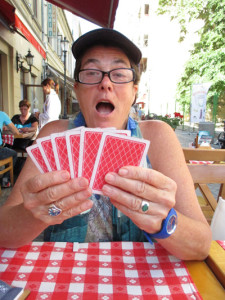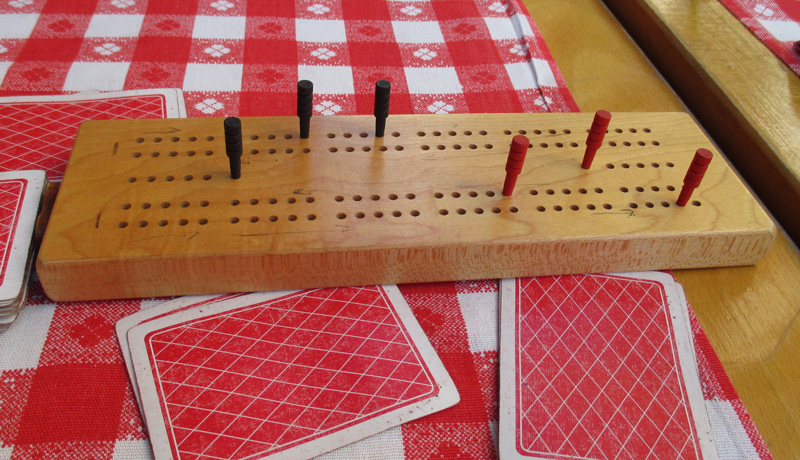People are different from each other. This is both obvious and simple while at the same time complex and difficult. We process information and experiences differently based on a whole host of scientific and esoteric reasons. It’s good for the species, it gives us variety, adaptability, a human for every situation.
However, when two or more humans attempt to coexist on a day to day basis, adjustments and adaptations must be made.
Like the cribbage board.
Cribbage is a card game played by counting points in each hand and pegging those points on a tall, narrow board with 60 holes in it for each player. The holes are arranged in two rows of 30 each. As a child I was taught to go up the outside of the board and down the inside of the board as the game progressed, making the entire circuit twice per game for a total of 120 points to win.
I’ve taught lots of people the game over the years. I taught my friend, Diane, 35 years ago. When we travel together, I keep the board and cards handy in my purse. Waiting in an airport? We play a hand or two. Dinner taking longer than expected? Break out the board.
Now, I taught Diane and we’ve played for many years, so you would think I’d know everything there is to know about Di and cribbage, but recently she surprised me.
I set up the board, putting the black pegs on the side nearest her with the bottom of the board (where the pegs start their path) toward the outside edge or bottom of the table. This is how I do it. How I’ve always done it. For 50-some years, this is how I’ve always done it.
Diane looked at the board, frowned, and said, “The pegs need to switch.” I was dumbfounded. I couldn’t figure out what she meant. Sighing with exasperation, she switched the pegs to the other side of the board, turned the board upside down with the starting point toward the inside of the table, and then smiled, completely satisfied and at ease.
I was even more confused. This was just wrong. Wrong. What was she thinking? I went ahead and played the game but it felt unnatural to me. I thought perhaps it was an anomaly.
It wasn’t.
 The next time we played, I set up the board the way I normally do, she said nothing and we played as we have all these years. But several days later, it happened again. With an air of frustration, she told me the board was wrong.
The next time we played, I set up the board the way I normally do, she said nothing and we played as we have all these years. But several days later, it happened again. With an air of frustration, she told me the board was wrong.
This time it pissed me off. How could it be right one day and wrong the next when I was doing it exactly—and I mean exactly—the same each time?
I asked her to explain it and she told me it needed to go right to left (or left to right, I still don’t quite understand) and the start position of the pegs needed to be nearest her right hand.
WTF? I’ve played the same game with the same person for 35 years and I didn’t know this? I explained about the bottom of the board being at the bottom of the table but that did not make sense to her. The discussion got a little heated, so we let it drop.
But it kept happening. One day I’d be right, the next day I’d get it wrong, she’d be exasperated and I’d get angry. Her explanation didn’t make sense to me; I couldn’t figure out what nearest her right hand actually meant. It began to feel like combat. Like I’d have to stop playing cribbage to avoid an argument.
Sometimes it’s a small thing that sheds light on a situation. We open all sorts of possibilities when we pay attention. In Nia (the holistic movement practice I teach) we talk about intimacy as paying attention. Even though I had been playing cribbage with Diane for 35 years, here was an opportunity for intimacy, to go deeper and pay attention.
I wish I could say I’m wise enough to have chosen to pay attention, but in this instance I have to say it was a moment of grace. At least I’m wise enough now to generally recognize grace when it presents itself.
I noticed that sometimes we played on the couch where Diane would sit to the right of me and sometimes we played at the dinner table where she would sit to my left. When we played at the table out on the deck, I sometimes sat on her right, sometimes to the left. This was the key to solving the issue. I realized if I always put her pegs on the left side of the board (as I see left), she could shift the board up or down (as I see up or down) so the start point is near her right hand. At least that’s how I can explain it.
You see, I still don’t quite get it. I sort of understand it intellectually, but I don’t process spatially the same way she does and it will always seem odd to me. As if my internal organization is up/down while hers is right/left. And I know that’s not how she would explain it. We found a solution because we wanted to but neither of us changed our spatial orientation to get there. We couldn’t, anymore than I could change my eyes from green to brown.
What we could do and did do was accept our differences and find a path to harmony despite them. Possible, doable, and done. I believe we both learned something about ourselves as well. There will be times we will not comprehend the other, not in that soul-mate, unspoken, everything flows in perfect harmony, we-are-one way.
Now, however, we have a way to enter into conversation when that happens. We start with, “It’s like the cribbage board…”


Nice story – love the pix